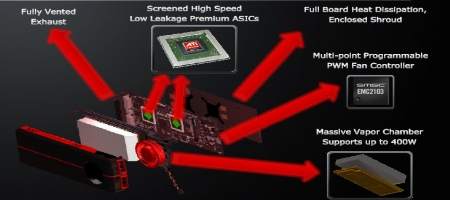Legion Hardware has reported that the ATI Radeon HD 5970 experienced certain overclocking “issues” during extended FurMark benchmarking.
According to Steve Walton, the tests were executed at 1680×1050 with an “increased run time,” as both GPUs were clocked at at 875MHz. GDDR5 memory remained at default specification levels, while the core voltage was raised to 1.1625v.
“With the core at 875MHz, the average frame rate was sitting at a fairly constant 115fps. However after just 40 seconds temperatures exceeded 100 degrees and shortly after this the Radeon HD 5970 overclocking problem presented itself,” wrote Walton. ??

“In order to avoid cooking itself, the Radeon HD 5970 throttles both cores down, negating any positive performance impact the overclock is going to have. However, rather than throttle the cores down just a little, or even to the default operating specification, it drops the frequency to just 550MHz, that’s a 24 percent under clock on each core.”
Walton explained that the clock decrease dropped the average frame rate from 115fps to “well under” 100 FPS.
“Eventually the average was reduced to 90fps, which is a 22 percent drop in performance.” ??

However, AMD’s Dave Baumann told TG Daily that the FurMark results indicated the 5970 was functioning as per its design specifications.
“The Legion FurMark results tell me that the 5970 is doing exactly what it was designed to do. There are protection measures in place that kick in when thermal or power levels exceed maximum permitted levels, so the card was taking the correct actions to protect both itself and the motherboard,” said Baumann. ??

“Now, I would also like to note that this particular benchmark (FurMark) was coded primarily as a stress test. It is certainly not elective in how it utilizes the GPU, as the application basically lights up the entire card to create or emulate maximum power draws and scenarios. No real world app or game does that for an extended period of time. FurMark was lighting up everything, with average power draws exceeding the requirements of any standard app by 20-40 percent. ??

“As I explained earlier, the 5970 has critical mechanisms in place to protect a system’s hardware. So, what would generally happen in an extreme extended overclocking scenario? Yes, the clock cycle decreases, but returns to overclocking speeds as soon as thermal temperatures stabilize.
“I wouldn’t say that this happens in many cases in an extended overclocking session – with normal apps most will run fine, but if we do hit a case where a game is particularly stressful in some areas then usually it will not last long and then return to the OC speeds when the power or temperatures have got back in check.?
“In my opinion, the Legion Hardware article illustrates that our card is working exceptionally well – exactly in the way it is supposed to.”
See Also
ATI reveals Radeon 5970 overlocking details
AMD debuts ATI Radeon 5970 GPU
?Slideshow: ATI Radeon HD 5970
Phenom II overclockers shatter 7GHz barrier
AMD powered Jaguar wins supercomputer race








